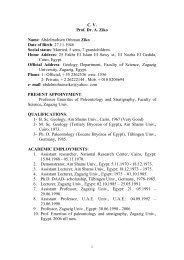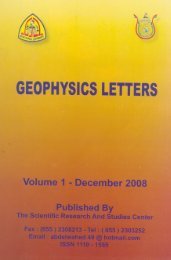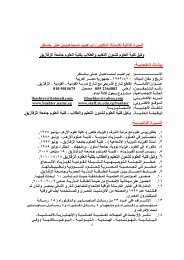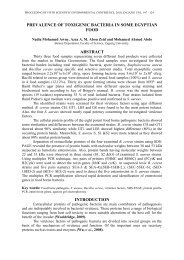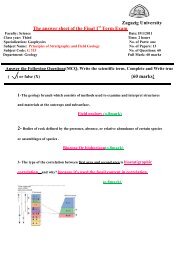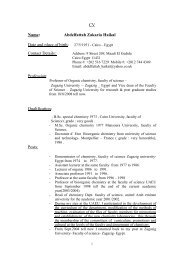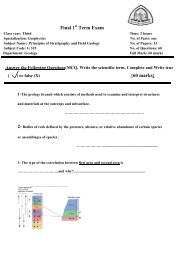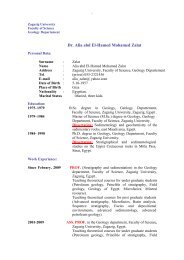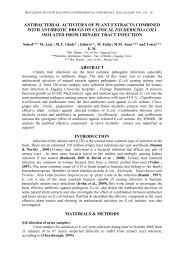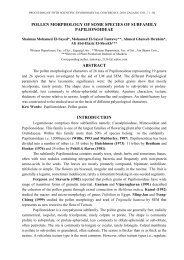flood hazard betwee marsa alam - ras ba as, red sea, egypt abstract ...
flood hazard betwee marsa alam - ras ba as, red sea, egypt abstract ...
flood hazard betwee marsa alam - ras ba as, red sea, egypt abstract ...
You also want an ePaper? Increase the reach of your titles
YUMPU automatically turns print PDFs into web optimized ePapers that Google loves.
28M. A. Azabrunoff and consequently incre<strong>as</strong>e its velocity. These parameters incre<strong>as</strong>e the fl<strong>as</strong>h <strong>flood</strong>potentiality.Wadi El Ranga B<strong>as</strong>in is fifth order and h<strong>as</strong> an area of about 310 km2. It is relatively den<strong>sea</strong>nd h<strong>as</strong> variable angles of juncture. Its drainage network pattern is denderitic to subdenddriticin parts and parallel to subparallel in others. The trunk wadi (wadi Ranga) flows NNE, NNWand E-W substantial segments of the main channel and large tributaries are guided by faults.Lithology is dominated by <strong>ba</strong>sement rocks with only small outcrops of Neogene andQuaternary sediments exposed near the mouth. This <strong>ba</strong>sin is characterized by ruggedmountainous relief (up to 1976 m high), low bifurcation ratio and very steep slope in theupper and middle reaches, which indicates high potential for <strong>flood</strong> <strong>hazard</strong>s at these parts.Wadi Kh<strong>as</strong>hir B<strong>as</strong>in is a sixth order and occupies an area of 464 km 2 . Its drainage net iswell developed, relatively dense and h<strong>as</strong> variable angles of juncture. The <strong>ba</strong>sin drains highmountains (up to 1658 m high) with very steep slopes. The relatively large channels arearranged in parallel pattern. Trellis pattern is also developed. Wadi Kh<strong>as</strong>hir is oriented E-W inthe upper part and NE in the middle and lower pat1s. Large tributaries are mostly directed EWand NE and less significantly at north. Metavolcanics, met<strong>as</strong>ediments and granites are thewidespread lithologic units exposed in the middle and upper parts. Neogene and Quaternarysediments are exposed at the mouth towards the Red Sea. Local fans are common at the footslops of the mountainous relief. The <strong>ba</strong>sin is characterized by very steep slope and low valuesof Rb in the upper part which leading to produce high peak flow. It is also characterized bylow drainage density and low stream frequency, which tends to produce moderate <strong>flood</strong>intensity especially, along the permeable downstream part. The <strong>ba</strong>sin tends to be elongated inshape and therefore, can be cl<strong>as</strong>sified <strong>as</strong> a low danger <strong>ba</strong>sin. Consequently, it is conside<strong>red</strong> <strong>as</strong>a good location for groundwater harvesting.Wadi Lahmi B<strong>as</strong>in is of sixth order and h<strong>as</strong> an area of about 967km 2 (Table 3). It is roughlyrectangular, well integrated; dense and h<strong>as</strong> variable angles of juncture. Its drainage patternsare trellis to sub trellis, radial in parts, and sub parallel in others. The trunk wadi (WadiLahmi) flows NNE to W-E and again NNE. Its large tributaries are mostly oriented E-W,NNW and NNE. Substantial segments of these channels are controlled by faults. Lithology isdominated by <strong>ba</strong>sement rocks with small outcrops of Neogene and Quaternary sedimentsexposed near the mouth. This <strong>ba</strong>sin is characterised by rugged mountainous relief (up to 1590m high), steep slope, low bifurcation ratio and circular shape. This indicates that there is ahigh potential for <strong>flood</strong> <strong>hazard</strong>s at the upper reaches of the <strong>ba</strong>sin and the downstream part ofthe trunk wadi.Rainfall And Surface RunoffThe study area is characterized by arid climate and dominated by hot temperatures, rainlesssummer and mild winter. The average annual precipitation rate is about 17.4 mm(meteorological stations of R<strong>as</strong> Ban<strong>as</strong>). Most of precipitation occurs <strong>as</strong> heavy showers withshort duration, results in fl<strong>as</strong>h <strong>flood</strong>s during the winter se<strong>as</strong>on <strong>betwee</strong>n October and February.The maximum amount of precipitation recorded in one day w<strong>as</strong> 64 mm (24 November 1966).The monthly mean temperature varies <strong>betwee</strong>n 24-38 °C during summer and 12-26 °C duringwinter. The relative humidity varies <strong>betwee</strong>n 28% in summer and 59% in winter. The averageevaporation, transpiration varies <strong>betwee</strong>n 8.7 mm/day in winter and 28 mm/day in summer.According to the above-mentioned climatic parameters, the study area receives an averagerainfall quantity equals to 98.75 million cubic meters/year (Table 3). It is a huge amount ofdownstream outlet. However, a considerable amount will be evaporated.



